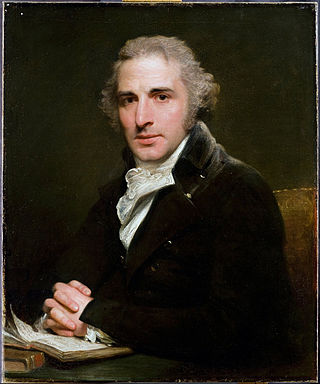
Drury Lane is a street on the eastern boundary of the Covent Garden area of London, running between Aldwych and High Holborn. The northern part is in the borough of Camden and the southern part in the City of Westminster. Drury Lane is part of London's West End Theatreland.
Events from the year 1809 in literature.

The Royal Opera House (ROH) is an opera house and major performing arts venue in Covent Garden, central London. The large building is often referred to as simply Covent Garden, after a previous use of the site. It is the home of The Royal Opera, The Royal Ballet, and the Orchestra of the Royal Opera House. The first theatre on the site, the Theatre Royal (1732), served primarily as a playhouse for the first hundred years of its history. In 1734, the first ballet was presented. A year later, the first season of operas, by George Frideric Handel, began. Many of his operas and oratorios were specifically written for Covent Garden and had their premieres there.

William Charles Macready was an English stage actor.

George Stephen Kemble was a successful English theatre manager, actor, and writer, and a member of the famous Kemble family. He was described as "the best Sir John Falstaff which the British stage ever saw" though he also played title roles in Hamlet and King Lear among others. He published plays, poetry and non-fiction.

John Philip Kemble was a British actor. He was born into a theatrical family as the eldest son of Roger Kemble, actor-manager of a touring troupe. His elder sister Sarah Siddons achieved fame with him on the stage of the Theatre Royal, Drury Lane. His other siblings, Charles Kemble, Stephen Kemble, Ann Hatton, and Elizabeth Whitlock, also enjoyed success on the stage.

Joseph Grimaldi was an English actor, comedian and dancer, who became the most popular English entertainer of the Regency era. In the early 1800s, he expanded the role of Clown in the harlequinade that formed part of British pantomimes, notably at the Theatre Royal, Drury Lane and the Sadler's Wells and Covent Garden theatres. He became so dominant on the London comic stage that the harlequinade role of Clown became known as "Joey", and both the nickname and Grimaldi's whiteface make-up design were, and still are, used by other types of clowns. Grimaldi originated catchphrases such as "Here we are again!", which continue to feature in modern pantomimes.

The Theatre Royal, Drury Lane, commonly known as Drury Lane, is a West End theatre and Grade I listed building in Covent Garden, London, England. The building faces Catherine Street and backs onto Drury Lane. The building is the most recent in a line of four theatres which were built at the same location, the earliest of which dated back to 1663, making it the oldest theatre site in London still in use. According to the author Peter Thomson, for its first two centuries, Drury Lane could "reasonably have claimed to be London's leading theatre". For most of that time, it was one of a handful of patent theatres, granted monopoly rights to the production of "legitimate" drama in London.

Henry Holland was an architect to the English nobility.

Daniel Mendoza was a prominent English prizefighter in the 1780s and 90s, and was also highly regarded as an instructor of pugilism. He was of Sephardic or Portuguese Jewish descent.

George Frederick Cooke was an English actor. As famous for his erratic habits as for his acting, he was largely responsible for initiating the romantic style in acting that was later made famous by Edmund Kean.

James Hook was an English composer and organist.

John Till Allingham was an English dramatist.

Henry Siddons was an English actor and theatrical manager, now remembered as a writer on gesture.

George Bartley (1782?–1858) was an English stage comedian. He was successful in playing comic old men and bluff uncles, and Falstaff became his favourite character. He had roles in many Shakespearean Comedies throughout his career spanning over half a century.

Maria Theresa Kemble (1774–1838), née Marie Thérèse Du Camp, was an Austrian-born English actress, singer, dancer and comic playwright on the stage. She was the wife of actor Charles Kemble.
Edmund John Eyre (1767–1816), was an English actor and dramatist.
Frederick Edward Jones (1759–1834) was an Irish theatre manager.
The somewhat involved history of the ownership and management of the Royal Opera House, Covent Garden can be split up into four main categories: the successive physical theatre buildings; the managers of the various theatrical and operatic companies which played there ; the leaseholders of the opera houses built on the land; and the owners of the freehold. From the early 20th century the theatre's management tended to be split between a general administrator and a musical/artistic director.
Lionel Benjamin Rayner was an English actor, usually playing rustic characters. As an actor-manager he opened in 1831 a short-lived theatre in the Strand, London.
















